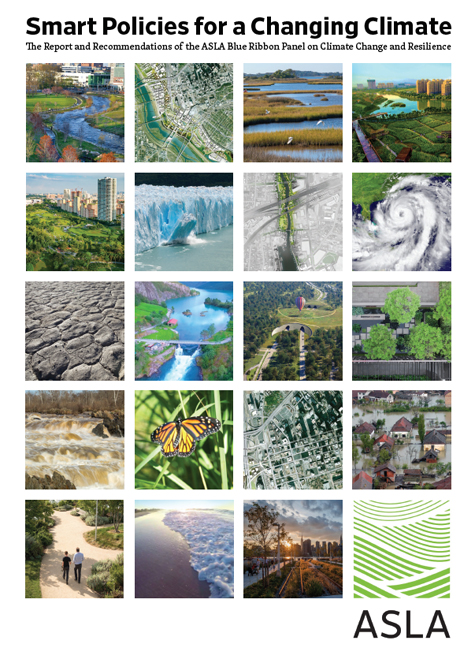Professional Practice
Climate Change Mitigation and Landscape Architecture
Download Report:
Global climate change is the defining environmental issue of our time. From devastating wildfires to historic storms and rising seas, the effects are already being felt and will continue to get worse. According to NASA, sea levels could rise anywhere from 8 inches to 6.5 feet by 2100. Additional impacts include increased spread of diseases; extensive species extinction; mass human, animal, and plant migrations; and resource wars over dwindling food and water supplies. Furthermore, these impacts will disproportionately affect the world’s poorest and most vulnerable communities.
Sustained, meaningful commitments and actions to substantially reduce greenhouse gas (GHG) emissions from all sectors of our economy can help avoid the worst of these negative impacts. The benefits of these actions will be measured in lives saved and communities spared.
In 2015, the international community gathered in Paris, France, and agreed to a landmark cooperative framework for limiting global temperature rise to “well below” 2 degrees Celsius above pre-industrial levels. In order to meet this goal, GHG emissions will need to peak by 2020 and fall to zero by 2050. This is an immense goal, but also achievable.
Landscape architects are helping to shift us to a carbon neutral future. They plan and design dense, walkable communities that reduce emissions from transportation and sprawl. They make the built environment more energy and carbon efficient with strategies like green roofs, water-efficient design, and use of sustainable materials and construction practices. They defend and expand carbon-sequestering landscapes such as forests, wetlands, and grasslands, helping to drawdown atmospheric carbon dioxide. All of these efforts also enable communities to better adapt to climate change and improve their resilience.
The threats posed by climate change are immense, and there is no single strategy that will solve the climate crisis on its own. Instead, mitigation requires an “all hands on deck” approach as we seek to reduce GHG emissions wherever possible. Achieving a carbon neutral future will only come about through the cumulative effect of countless individual actions. Every one of those individual actions counts.
U.S. Organizations
America's Pledge
Center for Climate and Energy Solutions
National Climate Adaptation Science Center, U.S. Geological Survey
National Renewable Energy Laboratory
National Oceanic and Atmospheric Association: Climate
U.S. Climate Alliance
U.S. Climate Action Network
U.S. Global Change Research Program
We Are Still In
International Organizations
Climate Change, United Nations Environment Programme
The Climate Group
European Commission Directorate for the Environment
The Global Environment Facility
IPCC (Intergovernmental Panel on Climate Change)
Mission 2020
United Nations Framework Convention on Climate Change (UNFCCC)
World Resources Institute
Resources
Amid the Climate Crisis, Glimpses of a Sustainable Future, The Dirt blog, March 15, 2018
Climate Action Tracker
Climate Change Indicators: U.S. Greenhouse Gases, U.S. Environmental Protection Agency
The Emissions Gap Report, UN Environment
Fifth Assessment Report (AR5), IPCC
Household Carbon Footprint Calculator, U.S. Environmental Protection Agency
Landscape Architecture and the Challenge of Climate Change, The Landscape Institute
The Paris Climate Agreement (2015)
Smart Policies for a Changing Climate, American Society of Landscape Architects
Ultimate Climate Change FAQ, The Guardian
United States Mid-Century Strategy for Deep Decarbonization (2016)
Research
Climate.gov, National Oceanic and Atmospheric Association
Global Change Reports and Assessments, U.S. Global Change Research Program
Inventory of U.S. Greenhouse Gas Emissions and Sinks: 1990-2016, U.S. Environmental Protection Agency
Project Drawdown
Carbon Registries and Markets
The World's Carbon Markets, The Environmental Defense Fund
American Carbon Registry
The Carbon Market Institute (Australia)
Climate Registry
The European Union Emissions Trading System
The Regional Greenhouse Gas Initiative
This guide was written by Andrew Wright.
This guide is a living resource so we invite you to submit research
studies, news articles, and case studies you would like to see included.
Please e-mail them to ASLA at info@asla.org